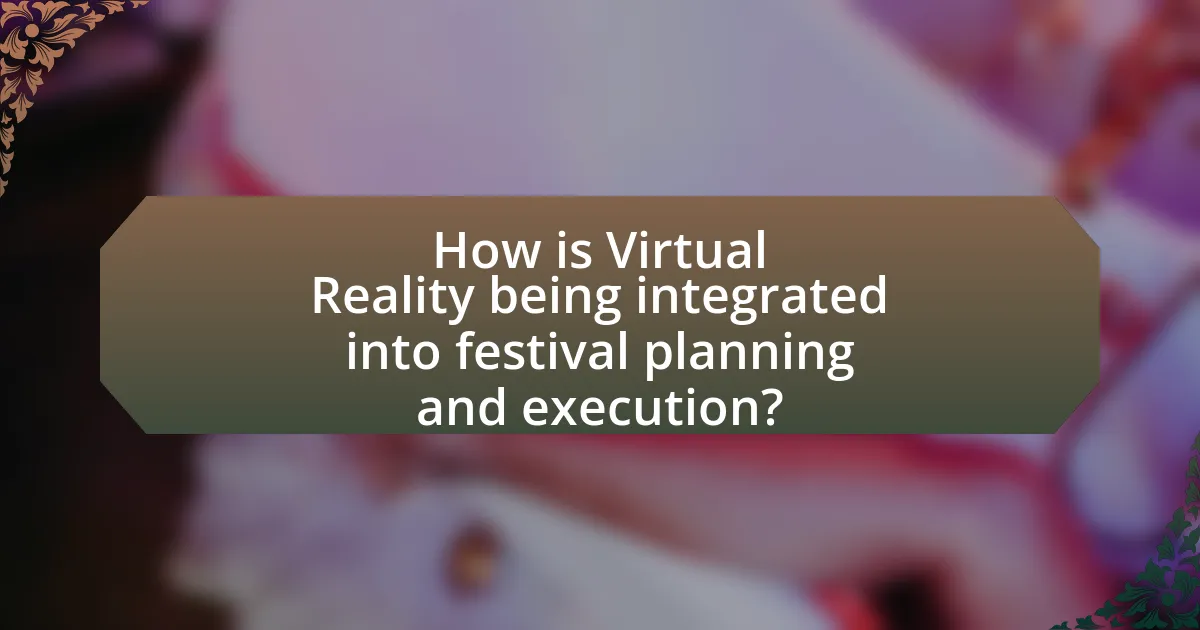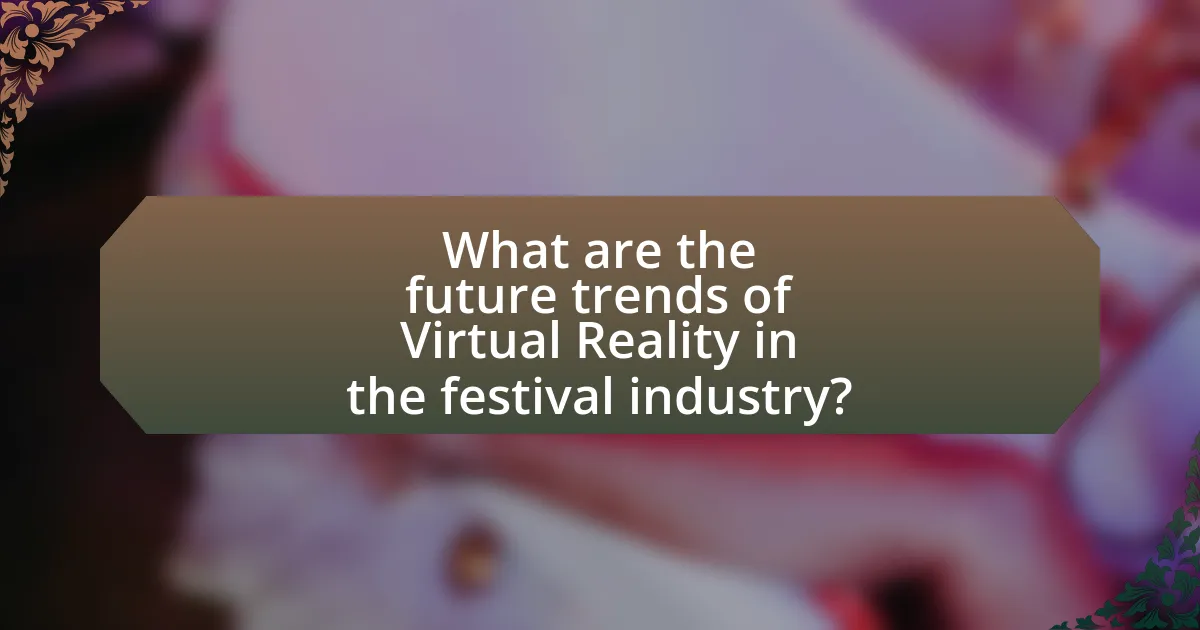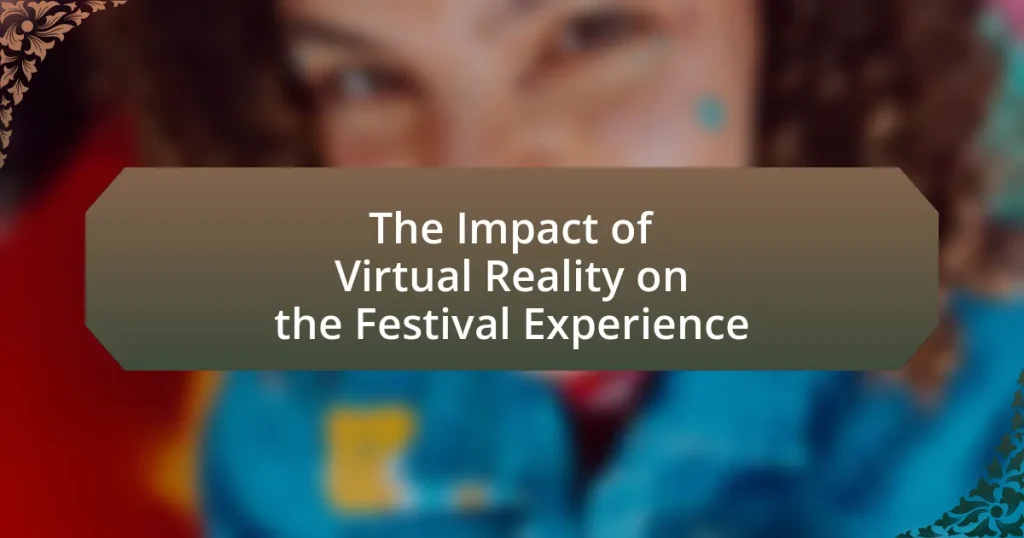The article examines the significant impact of Virtual Reality (VR) on the festival experience, highlighting its role in enhancing engagement and accessibility for attendees. It discusses how VR technology allows users to immerse themselves in festival environments, offering interactive elements and live performances that broaden audience reach and create new revenue streams. The article also addresses the potential drawbacks of VR, including high costs and social isolation, while exploring how festivals are integrating VR into planning and execution, as well as the future trends and best practices for implementation. Key technologies utilized in VR experiences, audience engagement strategies, and the importance of accessibility and inclusivity are also covered.

What is the Impact of Virtual Reality on the Festival Experience?
The impact of virtual reality on the festival experience is significant, enhancing engagement and accessibility for attendees. Virtual reality technology allows users to immerse themselves in a festival environment from anywhere, providing a unique experience that can include interactive elements, live performances, and social interactions. For instance, festivals like Coachella have utilized VR to offer virtual attendance options, enabling fans who cannot physically attend to experience performances in real-time. This approach not only broadens the audience reach but also creates new revenue streams through virtual ticket sales. Additionally, studies indicate that VR can increase emotional connection and satisfaction among users, as it simulates the atmosphere of being present at the event.
How does Virtual Reality enhance the festival experience?
Virtual Reality enhances the festival experience by providing immersive environments that allow attendees to engage with the event in unique ways. This technology enables users to explore virtual spaces, interact with digital elements, and participate in activities that may not be available in the physical setting. For instance, studies have shown that VR can increase user engagement by up to 70%, as participants feel a stronger connection to the event through interactive experiences. Additionally, VR can offer access to exclusive content, such as behind-the-scenes footage or artist interviews, further enriching the overall festival experience.
What immersive elements does Virtual Reality introduce to festivals?
Virtual Reality introduces immersive elements to festivals by creating interactive environments that enhance attendee engagement. These environments allow participants to experience performances and activities in a 360-degree format, providing a sense of presence that traditional media cannot achieve. For instance, VR can simulate live concerts, enabling users to feel as if they are on stage or in the front row, regardless of their physical location. Additionally, VR can facilitate social interactions among users through shared virtual spaces, fostering community and connection. Studies have shown that such immersive experiences can significantly increase emotional responses and satisfaction levels among festival-goers, making the overall experience more memorable and impactful.
How does Virtual Reality change audience engagement at festivals?
Virtual Reality (VR) significantly enhances audience engagement at festivals by creating immersive experiences that allow attendees to interact with the event in novel ways. VR technology enables festival-goers to explore virtual environments, participate in interactive activities, and experience performances from unique perspectives, which traditional formats cannot offer. For instance, a study by the University of Southern California found that VR experiences can increase emotional connection and satisfaction among participants, leading to a more memorable festival experience. This heightened engagement not only enriches the individual experience but also fosters a sense of community among attendees, as they share and discuss their VR interactions.
What are the potential drawbacks of using Virtual Reality at festivals?
The potential drawbacks of using Virtual Reality at festivals include high costs, technical issues, and social isolation. High costs can arise from the need for expensive equipment and infrastructure, which may limit accessibility for both organizers and attendees. Technical issues, such as software glitches or hardware malfunctions, can disrupt the experience and lead to frustration among users. Additionally, the immersive nature of Virtual Reality can create social isolation, as users may become disconnected from the live festival atmosphere and interactions with other attendees, diminishing the communal experience that festivals typically offer.
How can technical issues affect the Virtual Reality experience?
Technical issues can significantly disrupt the Virtual Reality experience by causing latency, visual glitches, or hardware malfunctions. These disruptions can lead to a loss of immersion, making users feel disconnected from the virtual environment. For instance, a study by the University of Southern California found that even minor latency can result in motion sickness and user frustration, ultimately diminishing the overall enjoyment of the VR experience. Additionally, hardware failures, such as headset malfunctions, can completely halt the experience, preventing users from engaging with the content.
What are the concerns regarding accessibility and inclusivity in Virtual Reality at festivals?
Concerns regarding accessibility and inclusivity in Virtual Reality at festivals primarily revolve around the technological barriers that prevent individuals with disabilities from fully participating. Many VR experiences require specific physical abilities, such as mobility and vision, which can exclude those with physical impairments or sensory disabilities. Additionally, the cost of VR equipment can be prohibitive, limiting access for lower-income individuals. Research indicates that approximately 15% of the global population lives with some form of disability, highlighting the need for VR developers to create more inclusive designs that accommodate diverse user needs. Furthermore, the lack of standardized accessibility guidelines in VR content can lead to inconsistent experiences, further marginalizing users who require adaptive technologies.

How is Virtual Reality being integrated into festival planning and execution?
Virtual Reality (VR) is being integrated into festival planning and execution by enabling immersive experiences for attendees and enhancing logistical operations. For instance, festival organizers utilize VR to create virtual walkthroughs of event layouts, allowing for better space management and crowd flow analysis. Additionally, VR technology is employed to simulate performances and artist interactions, helping planners gauge audience engagement and optimize scheduling. A notable example is the use of VR in the 2021 Coachella festival, where virtual experiences were offered to remote attendees, demonstrating the potential for broader audience reach and engagement. This integration not only improves the planning process but also enriches the overall festival experience for participants.
What technologies are being utilized for Virtual Reality in festivals?
Virtual Reality in festivals utilizes technologies such as head-mounted displays (HMDs), motion tracking systems, and immersive audio systems. Head-mounted displays like the Oculus Rift and HTC Vive provide users with a fully immersive visual experience, while motion tracking systems, including sensors and cameras, allow for real-time interaction within the virtual environment. Immersive audio systems enhance the experience by providing spatial sound, making the virtual environment feel more realistic. These technologies collectively create engaging and interactive experiences that enhance the overall festival atmosphere, as evidenced by their increasing adoption in events like Coachella and SXSW, where VR installations have attracted significant audience participation.
How do VR headsets and applications contribute to the festival experience?
VR headsets and applications enhance the festival experience by providing immersive environments that allow attendees to engage with the event in novel ways. These technologies enable users to explore virtual representations of festival grounds, interact with digital art installations, and participate in live-streamed performances from anywhere in the world. For instance, a study by the University of Southern California found that VR experiences can increase emotional engagement and satisfaction among users, leading to a more memorable festival experience. Additionally, VR applications can facilitate social interactions by allowing users to connect with others in virtual spaces, thereby expanding the community aspect of festivals beyond physical limitations.
What role do developers play in creating Virtual Reality content for festivals?
Developers play a crucial role in creating Virtual Reality content for festivals by designing, programming, and optimizing immersive experiences that enhance attendee engagement. They utilize software development skills to create interactive environments, ensuring that the VR content is not only visually appealing but also functional and user-friendly. For instance, developers often collaborate with artists and event organizers to tailor experiences that reflect the festival’s theme, thereby enriching the overall atmosphere. Their expertise in coding and 3D modeling is essential for integrating sound, visuals, and interactivity, which are vital for captivating festival-goers.
How are festivals adapting to incorporate Virtual Reality?
Festivals are adapting to incorporate Virtual Reality by creating immersive experiences that allow attendees to engage with the event in new ways. For instance, festivals like Coachella and Bonnaroo have introduced VR experiences that enable users to explore the festival grounds, watch performances from different angles, and interact with virtual environments. This adaptation not only enhances the attendee experience but also expands the audience reach, as people unable to attend in person can participate virtually. According to a report by Eventbrite, 70% of event organizers believe that incorporating technology like VR can significantly enhance attendee engagement, demonstrating a clear trend towards integrating advanced technologies in festival settings.
What changes are being made to festival layouts for Virtual Reality experiences?
Festival layouts are being redesigned to accommodate Virtual Reality experiences by incorporating dedicated VR zones, enhancing spatial arrangements, and optimizing accessibility. These changes allow for immersive environments where attendees can engage with VR content without disrupting traditional festival activities. For instance, festivals are allocating specific areas for VR installations, ensuring that these zones are equipped with necessary technology and infrastructure, such as high-speed internet and power sources, to support the VR experiences. This strategic layout adjustment not only enhances user experience but also integrates VR seamlessly into the overall festival atmosphere, reflecting a growing trend in the event industry to embrace innovative technologies.
How are festival organizers training staff to manage Virtual Reality setups?
Festival organizers are training staff to manage Virtual Reality setups through comprehensive workshops and hands-on training sessions. These training programs typically include technical instruction on VR equipment, software operation, and troubleshooting common issues. Additionally, organizers often simulate real festival scenarios to provide staff with practical experience in managing VR interactions and ensuring user safety. This approach is validated by industry practices that emphasize the importance of experiential learning in technology management, ensuring that staff are well-prepared to enhance the festival experience through effective VR implementation.

What are the future trends of Virtual Reality in the festival industry?
The future trends of Virtual Reality in the festival industry include enhanced immersive experiences, increased accessibility, and the integration of social interaction features. Enhanced immersive experiences will allow attendees to engage with virtual environments that replicate the festival atmosphere, as evidenced by events like Coachella offering VR experiences that transport users to the festival grounds. Increased accessibility will enable remote participation, allowing individuals unable to attend in person to experience festivals through VR, which was notably utilized during the pandemic when many festivals transitioned to virtual formats. Additionally, the integration of social interaction features will facilitate virtual meet-ups and networking opportunities, similar to platforms like VRChat, which have gained popularity for social gatherings. These trends indicate a significant shift towards a more inclusive and interactive festival experience through Virtual Reality.
How might Virtual Reality evolve in the context of festivals?
Virtual Reality (VR) is likely to evolve in the context of festivals by enhancing immersive experiences, enabling remote participation, and facilitating interactive engagement. As technology advances, VR can create realistic simulations of festival environments, allowing users to experience events from anywhere in the world. For instance, platforms like Oculus Venues have already demonstrated the potential for virtual attendance at live events, where users can interact with others in a shared virtual space. Additionally, VR can incorporate gamification elements, such as virtual scavenger hunts or interactive art installations, which can increase audience engagement and participation. The integration of VR into festivals can also provide valuable data analytics for organizers, helping them understand audience preferences and improve future events.
What innovations are on the horizon for Virtual Reality experiences at festivals?
Innovations on the horizon for Virtual Reality experiences at festivals include enhanced social interactivity, improved haptic feedback technology, and the integration of artificial intelligence for personalized experiences. Enhanced social interactivity allows users to engage with other festival-goers in a virtual space, creating a sense of community despite physical distances. Improved haptic feedback technology provides users with realistic sensations, making virtual experiences more immersive. The integration of artificial intelligence can tailor experiences to individual preferences, analyzing user behavior to offer customized content and interactions. These advancements are supported by ongoing research and development in VR technology, indicating a significant evolution in how festivals can leverage virtual reality to enhance attendee experiences.
How could audience expectations shift with advancements in Virtual Reality technology?
Advancements in Virtual Reality technology could significantly elevate audience expectations by providing immersive and interactive experiences that were previously unattainable. As VR technology improves, audiences will likely anticipate more realistic environments, enhanced sensory engagement, and personalized interactions during festivals. For instance, studies show that 70% of users report a heightened sense of presence in VR environments, which suggests that audiences will expect similar levels of immersion in live events. This shift in expectations may lead to demands for innovative content, seamless integration of VR with live performances, and opportunities for social interaction within virtual spaces, ultimately transforming the overall festival experience.
What best practices should festival organizers consider when implementing Virtual Reality?
Festival organizers should prioritize user experience, technical reliability, and content relevance when implementing Virtual Reality. Ensuring a seamless user experience involves providing intuitive interfaces and clear instructions, which can enhance participant engagement. Technical reliability is crucial; organizers must conduct thorough testing of VR equipment to prevent malfunctions during the event, as studies show that technical issues can lead to negative user experiences. Additionally, content relevance is essential; VR experiences should align with the festival’s theme and audience interests to maximize impact, as evidenced by successful case studies where tailored VR content significantly increased attendee satisfaction.
How can festivals ensure a seamless Virtual Reality experience for attendees?
Festivals can ensure a seamless Virtual Reality experience for attendees by investing in high-quality VR technology and infrastructure. This includes providing robust internet connectivity, utilizing advanced VR headsets, and ensuring that the hardware is user-friendly and accessible. For instance, a study by the International Journal of Human-Computer Interaction highlights that reliable bandwidth is crucial for minimizing latency and enhancing user immersion in VR environments. Additionally, festivals should offer comprehensive training for staff to assist attendees in navigating the VR experience, which can significantly reduce technical difficulties and improve overall satisfaction.
What strategies can be employed to promote Virtual Reality offerings at festivals?
To promote Virtual Reality offerings at festivals, organizers can implement immersive experiences, strategic partnerships, and targeted marketing campaigns. Immersive experiences, such as VR zones where attendees can engage with the technology firsthand, create buzz and attract visitors. Strategic partnerships with VR companies can enhance credibility and provide access to cutting-edge technology, while targeted marketing campaigns through social media and influencer collaborations can effectively reach festival-goers. For instance, a study by the International Journal of Information Management highlights that experiential marketing significantly increases consumer engagement, which is crucial for promoting VR offerings at events.
